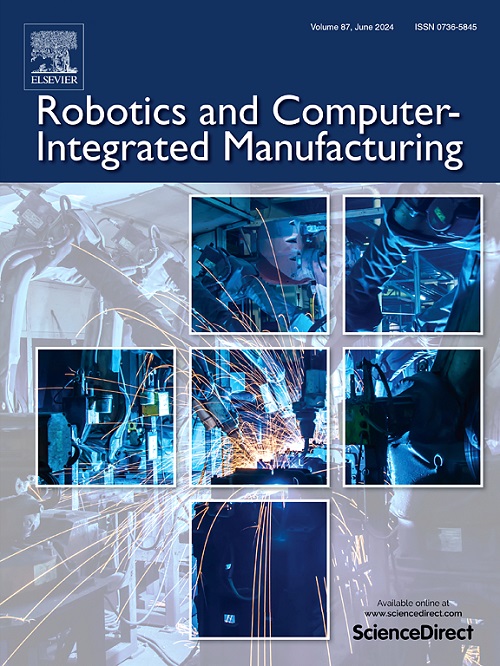Autogeneration and optimization of pick-and-place trajectories in robotic systems: A data-driven approach
IF 11.4
1区 计算机科学
Q1 COMPUTER SCIENCE, INTERDISCIPLINARY APPLICATIONS
引用次数: 0
Abstract
For manufacturing processes in industries such as aerospace, automotive and electronics, it is essential for robots to perform pick-and-place tasks with high efficiency and accuracy. To this end, we propose a data-driven framework to generate a pick-and-place trajectory that ensures high-accuracy tracking while simultaneously reducing residual vibration, which is particularly valuable for commercial industrial robots with unchangeable control systems. The proposed approach includes both the trajectory generation and the trajectory compensation phases. In the first phase, we plan a pick-and-place trajectory that effectively attenuate residual vibration by minimizing the acceleration energy within a specific frequency spectrum, where the frequency parameters and the time ratio are tuned by Bayesian optimization. In the second phase, we focus on improving the tracking accuracy by incorporating a trajectory compensation term. More precisely, we first learn a Koopman operator-based linear predictor, where a model-agnostic meta-learning framework is introduced to mitigate the demand for massive data from the target system. Then, we calculate the trajectory compensation term using an iterative learning control-based method. The proposed methodology is entirely data driven, enabling its application in various robotic systems and has potential in other manufacturing applications. We demonstrate the approach through high-fidelity simulations on Delta robots – a representative parallel robot, where trajectory generation effectively removes vibrations, and through physical experiments on UR5 robots – a typical serial robot. The results of the experiment show that the positioning accuracy of the three joints of the UR5 robot improved by 94%, 43%, and 96%.
机器人系统中拾取轨迹的自动生成和优化:数据驱动的方法
对于航空航天、汽车和电子等行业的制造过程,机器人高效、准确地执行取放任务至关重要。为此,我们提出了一个数据驱动的框架来生成一个拾取和放置轨迹,以确保高精度跟踪,同时减少残余振动,这对于具有不可更改控制系统的商业工业机器人特别有价值。该方法包括轨迹生成和轨迹补偿两个阶段。在第一阶段,我们规划了一个拾取轨迹,该轨迹通过最小化特定频谱内的加速度能量来有效地衰减残余振动,其中频率参数和时间比通过贝叶斯优化进行调整。在第二阶段,我们着重于通过加入轨迹补偿项来提高跟踪精度。更准确地说,我们首先学习了一个基于Koopman算子的线性预测器,其中引入了一个模型不可知的元学习框架,以减轻对目标系统大量数据的需求。然后,我们使用基于迭代学习控制的方法计算轨迹补偿项。所提出的方法完全是数据驱动的,使其能够在各种机器人系统中应用,并在其他制造应用中具有潜力。我们通过Delta机器人(一种典型的并联机器人,其轨迹生成有效地消除了振动)的高保真仿真以及UR5机器人(一种典型的串行机器人)的物理实验来证明该方法。实验结果表明,UR5机器人的三个关节的定位精度分别提高了94%、43%和96%。
本文章由计算机程序翻译,如有差异,请以英文原文为准。
求助全文
约1分钟内获得全文
求助全文
来源期刊
CiteScore
24.10
自引率
13.50%
发文量
160
审稿时长
50 days
期刊介绍:
The journal, Robotics and Computer-Integrated Manufacturing, focuses on sharing research applications that contribute to the development of new or enhanced robotics, manufacturing technologies, and innovative manufacturing strategies that are relevant to industry. Papers that combine theory and experimental validation are preferred, while review papers on current robotics and manufacturing issues are also considered. However, papers on traditional machining processes, modeling and simulation, supply chain management, and resource optimization are generally not within the scope of the journal, as there are more appropriate journals for these topics. Similarly, papers that are overly theoretical or mathematical will be directed to other suitable journals. The journal welcomes original papers in areas such as industrial robotics, human-robot collaboration in manufacturing, cloud-based manufacturing, cyber-physical production systems, big data analytics in manufacturing, smart mechatronics, machine learning, adaptive and sustainable manufacturing, and other fields involving unique manufacturing technologies.

 求助内容:
求助内容: 应助结果提醒方式:
应助结果提醒方式:


